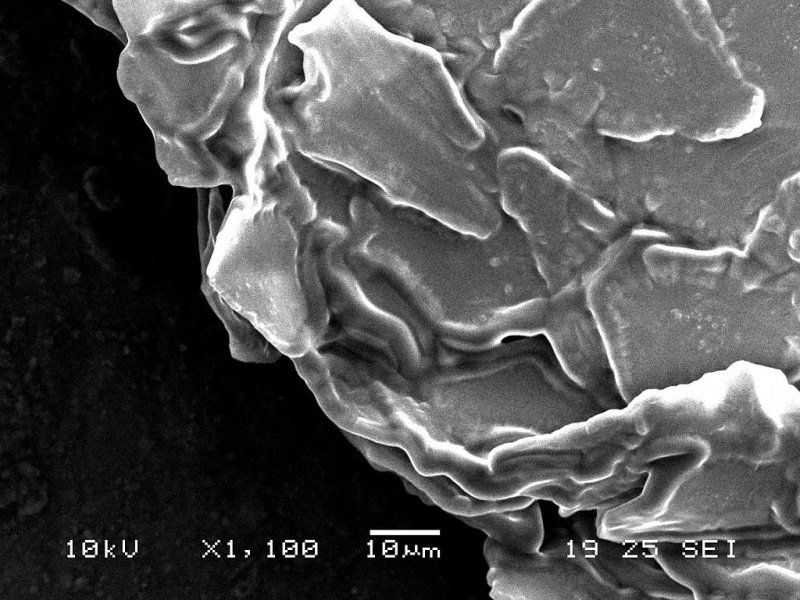What Does Dandruff Look Like Under a Microscope?
Last Updated on

If it’s been a few days since you’ve washed your hair, you might spot tiny white or yellow flakes accumulating on your scalp or drifting onto your shoulders. But did you know that a dandruff problem is a little bit more complicated than simply not washing your hair? That’s because dandruff can be caused by washing your hair too little or even too much, as over-washing can stimulate your scalp to create more oil to replace what was stripped away by harsh shampooing. Additionally, a certain yeast called Malassezia globosa feeds off of oily scalps, which promotes even more dandruff growth. We’ll give you a glimpse into what dandruff really looks like under a microscope, as well as ways to prevent it from occurring on your scalp.

What Does Dandruff Look Like at the Microscopic Level?
If you put dandruff under a microscope at 20x magnification, you’ll find mostly dead skin flakes that look similar to shredded coconut. You might see a little bit of blood from pimples, as well as small hairs. The thicker, more yellow dandruff flakes contain more oil than the more translucent, whitish ones that signify a drier scalp. Looking at your own dandruff under a microscope may help you determine if your flakes are more likely caused by excessively oily or excessively dry skin.

How to Look at Dandruff Under a Microscope
If you want to look at a slide from your own head, you might look for a common source such as your computer keyboard or hairbrush. Shake the loose follicles onto a microscope slide or look at it underneath a magnifying glass to see it closer. Here are the steps if you have a microscope:
Collect your samples. Hairbrushes or computer keyboards, or even your phone, can be good sources of dandruff. To be sure you’re getting dandruff instead of dust, you might even scrape a few flakes from your scalp.
- Pour a little bit of vegetable oil on your slide. You might want to prepare your microscope slide with a little bit of vegetable oil to help the dandruff stick.
- Sprinkle the dandruff on the slide. Using some tweezers, place a sample of dandruff on the slide. Protect with a slide cover.
- Start with 4x magnification. Increase from 4x to keep exploring what your dandruff looks like under the microscope. Clear, nearly translucent pieces of dandruff signify drier skin flakes while yellow, thicker pieces mean your hair and skin are on the oily side.
How to Prevent Dandruff
While dandruff might be entertaining to look at under a microscope, chances are you don’t really want to look at it on your head. The exact causes of dandruff are still unknown, so for now we’ll assume that there are actually two different causes which can be ironically connected: skin that’s too oily or too dry.
Excessively oily skin can cause dead skin follicles to build up, promoting dandruff and the growth of Malassezia globosa yeast, which in turn creates more dandruff. However, dry skin sheds smaller flakes, which also resembles dandruff.
Additionally, washing your hair too frequently or with harsh shampoos can strip your hair and scalp of its natural oils and signal your body to produce too much oil, which can also cause dandruff. Conversely, dandruff can also result from poor hygienic practices, such as not washing your hair enough.
There’s a theory that the Malassezia globosa yeast grows best in areas that don’t receive much sun, so you might try incorporating more time outside in your routine to fight the flakes. If you’re not sure how often to wash your hair, try skipping a few days to see what happens. If your scalp starts to get itchy, it’s time for a shampoo.

Final Thoughts
Looking at your own dandruff under a microscope can be a fun and informative activity that can give you some insight on why the tiny flakes are building up on your head. If you struggle with dandruff, you might try washing your hair not as often if you see dry flakes, or more often with a gentle shampoo if you see yellow crusty pieces.
Featured Image Credit by: Dandruff (Horoporo, via Wikimedia Commons CC BY-SA 3.0)
About the Author Brooke Bundy
Brooke Bundy is a freelance writer who lives with three cats and a dog. She attended the University of North Georgia where she acquired a B.S. in Media Studies. Booke loves storytelling and spending time with her pets at their house in New Orleans, Louisiana. In her free time, she enjoys gardening, cooking, and brewing coffee.
Related Articles:
How to Clean a Refractor Telescope: Step-by-Step Guide
How to Clean a Telescope Eyepiece: Step-by-Step Guide
How to Clean a Rifle Scope: 8 Expert Tips
Monocular vs Telescope: Differences Explained (With Pictures)
What Is a Monocular Used For? 8 Common Functions
How to Clean a Telescope Mirror: 8 Expert Tips
Brightfield vs Phase Contrast Microscopy: The Differences Explained
SkyCamHD Drone Review: Pros, Cons, FAQ, & Verdict
